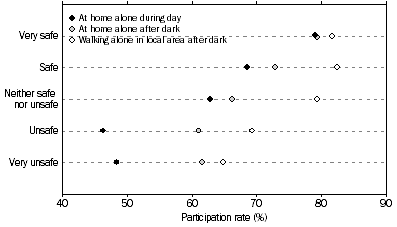FEELINGS OF SAFETY
An indirect measure of trust available from the GSS is people's feelings of safety while at home or walking alone. Feeling unsafe might relate to fear of threat from other people or the possibility of not having someone else around to provide help in the case of a health-related mishap, such as a fall. In either case it might be expected that having close links with others in one's vicinity or having established habits of contacting others for help if needed could increase feelings of safety (ABS 2006).
The GSS asked respondents how safe they felt in various circumstances - when home alone during the day, when home alone after dark and when walking alone through their local area after dark. Feelings of safety were reported on a five point scale ranging from very safe to very unsafe. Overall, GSS data show that the rate of participation in sport and physical recreation activity declines as feelings of safety diminish. For example, the participation rate is 79% for those who feel very safe at home alone during the day compared with 48% for those who feel very unsafe.
7.1 PARTICIPATION IN SPORT AND PHYSICAL RECREATION, By feelings of safety in various circumstances

In each of the three situations, a greater proportion of sport participants than non-participants reported strong feelings of safety in their local communities. When at home alone during the day, 96% of sport and physical recreation participants feel either very safe or safe compared with 90% of non-participants. Similarly, 88% of sport participants felt very safe or safe at home alone after dark compared with 79% of non-participants.
The difference in feelings of safety between sport participants and non-participants was most marked for walking alone in their local area after dark. Over half (53%) of sport participants felt very safe or safe in this situation compared with 33% of non-participants, while 15% of sport participants never walk alone after dark compared with 33% of non-participants.
7.2 Participation in Sport and Physical Recreation, By feelings of safety |
|
 |  | Participated | Did not participate | Total | Participation rate | Non-participation rate | Total |
 |  | '000 | '000 | '000 | % | % | % |
|
| Feelings of safety at home alone after dark |  |  |  |  |  |  |
 | Very safe | 5 954.5 | 1 557.4 | 7 511.9 | 79.3 | 20.7 | 100.0 |
 | Safe | 4 947.3 | 1 849.6 | 6 796.8 | 72.8 | 27.2 | 100.0 |
 | Neither safe nor unsafe | 766.4 | 390.8 | 1 157.1 | 66.2 | 33.8 | 100.0 |
 | Unsafe | 519.5 | 331.2 | 850.7 | 61.1 | 38.9 | 100.0 |
 | Very unsafe | 160.0 | 99.6 | 259.6 | 61.6 | 38.4 | 100.0 |
 | Never home alone after dark | *111.2 | 100.9 | 212.0 | 52.4 | 47.6 | 100.0 |
 | Total | 12 458.7 | 4 329.4 | 16 788.2 | 74.2 | 25.8 | 100.0 |
| Feelings of safety at home alone during day |  |  |  |  |  |  |
 | Very safe | 8 219.7 | 2 188.0 | 10 407.7 | 79.0 | 21.0 | 100.0 |
 | Safe | 3 701.9 | 1 700.3 | 5 402.2 | 68.5 | 31.5 | 100.0 |
 | Neither safe nor unsafe | 350.8 | 207.3 | 558.1 | 62.9 | 37.1 | 100.0 |
 | Unsafe | 123.4 | *142.5 | 266.0 | 46.4 | 53.6 | 100.0 |
 | Very unsafe | *33.1 | *35.3 | *68.3 | *48.4 | *51.6 | 100.0 |
 | Never home alone during the day | *29.9 | *56.1 | *86.0 | *34.8 | 65.2 | 100.0 |
 | Total | 12 458.7 | 4 329.4 | 16 788.2 | 74.2 | 25.8 | 100.0 |
| Feelings of safety walking alone in local area after dark |  |  |  |  |  |  |
 | Very safe | 2 327.5 | 524.6 | 2 852.1 | 81.6 | 18.4 | 100.0 |
 | Safe | 4 306.2 | 922.2 | 5 228.4 | 82.4 | 17.6 | 100.0 |
 | Neither safe nor unsafe | 1 784.6 | 464.5 | 2 249.1 | 79.3 | 20.7 | 100.0 |
 | Unsafe | 1 598.0 | 706.5 | 2 304.4 | 69.3 | 30.7 | 100.0 |
 | Very unsafe | 515.0 | 279.6 | 794.7 | 64.8 | 35.2 | 100.0 |
 | Never walk alone after dark | 1 927.5 | 1 432.0 | 3 359.5 | 57.4 | 42.6 | 100.0 |
 | Total | 12 458.7 | 4 329.4 | 16 788.2 | 74.2 | 25.8 | 100.0 |
|
| * estimate has a relative standard error of 25% to 50% and should be used with caution |
 Print Page
Print Page
 Print All
Print All